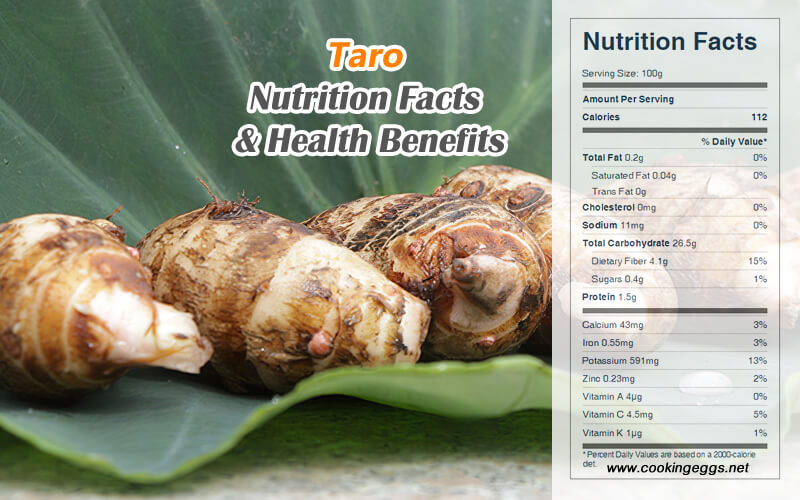Taro Nutrition Facts and Health Benefits
Taro is a tropical plant in the family Araceae that is used as a vegetable for its corms, leaves, and petioles. The leaves are high in minerals and vitamins A, B, and C. The young leaves are cooked and used for human consumption as a very nutritious vegetable, and the corms are used as a staple in place of rice or potato.
Nutritional value of Taro
Raw taro is 70% water, 26% carbohydrates, 1.5% protein, and contains negligible fat. It is a good source of vitamin B6, vitamin E, and manganese, and it also provides some phosphorus and potassium.
In a 100-gram reference amount, raw taro supplies 112 calories of food energy and is a rich source of vitamin B6 (25% of the Daily Value), vitamin E (20% of DV), a moderate source of manganese (21% of the Daily Value), and contains other B vitamins.
One-fourth cup of sliced taro provides 116 calories, 27.6 g carbohydrate, 1.56 g protein, 0.2 g fat, 4.26 g dietary fiber, 79 IU vitamin A, 4.68 mg vitamin C, 2.48 mg vitamin E, 615 mg potassium, 11 mg sodium, 87.4 mg phosphorus, 44.7 mg calcium, 0.57 mg iron, 34.3 mg magnesium, 0.23 mg zinc, and 0.39 mg manganese.

Raw Taro Nutrition Facts Label
Health Benefits of Taro
The corms of taro are used as vegetables and are considered a rich source of carbohydrates, proteins, minerals, and vitamins. They are accredited to have medicinal values and are used to reduce tuberculosis, ulcers, pulmonary congestion, fungal infection, and reduce body temperature in a feverish patient, among others.
In the Philippines, taro is used as medicine. The leaves and corms were boiled and eaten by women experiencing a difficult childbirth. Many tribes believed the early morning dew that collected on the leaves was excellent medicinal eyewash. Women with dysmenorrheal were made to sit on taro leaves. The juice of the petioles is styptic and was used to arrest arterial hemorrhage. Taro was used for earaches, as an external stimulant, and as a rubefacient. Taro was used as a laxative in cases of hemorrhoids. Some tribes use taro as an antidote to the stings of wasps and other biting or stinging insects. Heated tubers were applied to painful parts in rheumatism. In the mouth, honey mixed with tuber ash was used as a cure for apthae. In Hawaii, the raw juice mixed with sugar was taken orally to reduce fever. Taro was used by Hawaiians to treat illnesses ranging from constipation to tuberculosis.
Taro contains more than twice the carbohydrate content of potatoes. Taro contains about 11% protein on a dry weight basis. This is more than yam, cassava, or sweet potato. It also stated that the protein content of taro is higher than the other root crops. It contains 85-87% starch on a dry matter basis with small granules and other nutrients such as minerals, Vitamin C, thiamin, riboflavin, and niacin better than cereals.
Taro's nutritional quality and chemical composition The nutritional composition of taro corm, like other root crops, is low in protein and fat, but high in carbohydrates. It is a good source of potassium and provides a moderate level of phosphorus. It is low in vitamin C and deficient in vitamins A and B. The root of Taro corm is a good source of minerals, and the small granule size of its starch helps increase the bioavailability of its nutrients due to the efficiency of digestion and absorption.
The starch contained in the large corms of taro is highly digestible, therefore making it a good source of carbohydrates and, to a lesser degree, a source of potassium and protein. Taro is good for people allergic to milk or cereals and can be consumed by children who are sensitive to milk. The digestibility of taro starch has been estimated to be 98.8 percent. Therefore, taro flour and other products have been used for infant formula in the United States and have formed an important constituent of proprietary canned baby foods.
Taros has a high concentration of beta-carotene in the corm, which provides vitamin A and antioxidant properties to the body. Beta-carotene differs only very slightly in terms of structure. They are very common carotenoids, and are antioxidants, as well as having other potential health benefits. Both can be converted into vitamin A by the body, though beta-carotene has about twice the provitamin A activity as beta-carotene.
When raw taro corms are cut into pieces, the exposed surfaces often exude droplets of a slimy substance called mucilage. The pieces or slices of corm are washed or placed in portable water; a great quantity of mucilage is quickly released or avoided. The crude mucilage is a complex mixture composed mainly of neutral polysaccharides with small quantities of fiber and protein. Mucilage can be removed by discarding the water used for cooking, or acid ingredients such as lemon juice can be used to neutralize the slimy effect, or the taro can be cooked without water (e.g., fried or baked) in a manner that leads to partial dehydration and a dry texture. However, the mucilage in taro corms is important for health because of its digestibility and lowers blood cholesterol by binding bile, slowing blood glucose and food transit through the upper GI tract, absorbing water and holding moisture that softens stool.
Health Risk
If taro is not prepared and cooked well, the acridity will cause itchiness in the mouth and throat. All parts of taro can cause stomach aches if ingested without cooking. Contact with the sap can irritate sensitive skin.